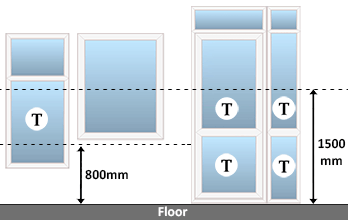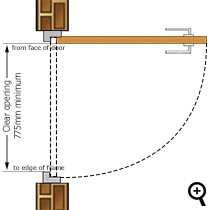Abbreviated advice for Building Regulations
Various Building Regulations apply to replacement windows and doors. This is just a brief incomplete summary, please read the disclaimer at the bottom, and see the actual Approved Documents for more.
How do I get a FENSA certificate?
FENSA certificates certify the actual installation. Your installer should be able to issue a FENSA certificate. If not, or you are installing yourself, your local Building Control can certify your installation. More information: www.fensa.co.uk.
Fire Escape - summary of Document Part B
Ground floor windows: Fire escape windows are required on the ground floor in any habitable room (not a kitchen or bathroom) which does not open into a hall that leads directly to an exit door.
Upper floor windows: On upper floors up to 4.5 meters from ground level, all habitable rooms (not kitchens or bathrooms) must be fitted with fire escape windows, unless the room has direct access to a protected stairway.
A fire escape window's openable area should be less than 1100mm from the floor and should open without obstruction to at least 0.33m² and at least 450mm high or 450mm wide. If one of the dimensions is at the 450mm minimum then the other dimension will need to be at least 734mm to achieve 0.33m2.
Windows fitted with our Fire Escape and Easy Clean hinges comply with the above regulations as long as the openings are sufficient; we recommend 600mm pane width to achieve the clear 450mm width.
Ventilation - summary of Document Part F1
New regulations, effective from 15th June 2022!
All rooms must be adequately ventilated to avoid the accumulation of contaminants and/or condensation. Good indoor air quality is important for health and also has many benefits to the building itself.
| Minimum Equivalent Area of all trickle vents per room | ||
|---|---|---|
| Dwelling with multiple floors | Single floor dwelling | |
| Habitable rooms & kitchens | 8,000 mm² | 10,000 mm² |
| Bathrooms | 4,000 mm² | 4,000 mm² |
| Utility & WC/cloakrooms | none | none |
Abbreviated regulations
- If replacing a window that already has trickle vents, the new window should have at least the same number and mm² of vents.
- If however the original window does not have vents or it's a new window, vents will be needed per the above table (unless there are other ventilation methods).
- If it's not technically feasible to fit vents with as much Equivalent Area mm² as needed, aim for as close as possible.
- Typically trickle vents are positioned at least 1.7 metres above finished floor level to avoid discomfort due to draughts.
- Expert advice needed if the dwelling has only one exposed facade, or has 70% of openings on the same facade, or for window-less rooms.
- Open plan kitchens need at least 3 vents of the same size as other rooms.
- Purge ventilation: Minimum opening size of all window openers and all doors to be 1/20th of the floor area of each room.

Glazing Safety - summary Document Part K4 & N1
Toughened or laminated glass is required in critical locations which are subject to accidental human impact, as a minimum:
- Glazing at low levels: if the bottom of the glazing is within 800mm of the floor level.
- Glazing in doors: any glass in doors that starts lower than 1,500mm from the floor.
- Glazing adjacent to doors: windows/side panels starting within 300mm of the edge of a door and also starting within 1,500mm from the floor.
The example diagram to the right shows glass panes where toughened or laminated safety glass is required, marked with:
Conservation of fuel & power - summary of Document part L1
New regulations, effective from 15th June 2022!
Abbreviated regulations- Glazed area should not exceed 25% of floor area.
- No worse in energy efficiency than previous windows/doors.
- New dwelling: Windows & doors should be sealed with air sealing tape.
| Minimum Energy Efficiency ratings | |||||
|---|---|---|---|---|---|
| Windows | Rooflights | Doors over 60% glass | Doors less 60% glass | What complies? | |
| Existing dwelling: | 1.4u (B rating) | 2.2u | 1.4u (C rated) | 1.4u (B rated) | all our windows & doors |
| New built - Notional: | 1.2u | 1.7u | 1.2u | 1.0u | our triple glazed A++ |
| New built - Limiting: | 1.6u | 2.2u | 1.6u | 1.6u | all our windows & doors |

Access - summary of Document Part M1
For replacement doors, the new door should be the same or more accessible than the previous door. The height of the door threshold- cill should not be made worse.
For new build homes, external doors should have a threshold-cill no higher than 35mm, except in areas of high weather exposure, in which case up to 50mm is acceptable. If that is not possible due to design considerations, a maximum gap of 35mm measured from the underside of the door leaf to the finished internal floor level would be acceptable.
The opening width of principal doors, should be a clear minimum of 775mm, from the edge of the frame to the face of the door leaf open at 090 degrees.
Security for new builds and extensions - summary of Document Part Q
- Accessible (roughly somewhere a burglar could possibly reach) windows and doors must:
- Comply with British Standards PAS 24:2012 (also usually included in Secured By Design).
- Main entrance doors must have a spyhole or clear glass, and a door chain, and any letter plates need to comply with TS008.
- Windows that open without key locking must have laminated glass. (Our windows have key locks on all openers).
- Door glazing and glazing near doors (side panels or windows) must be laminated.







